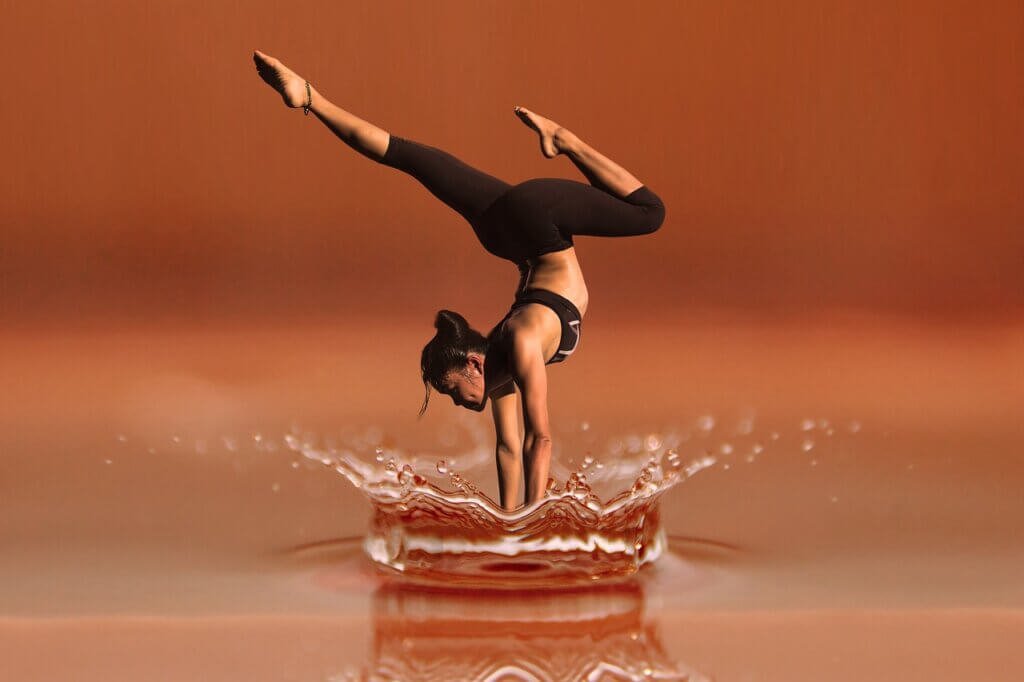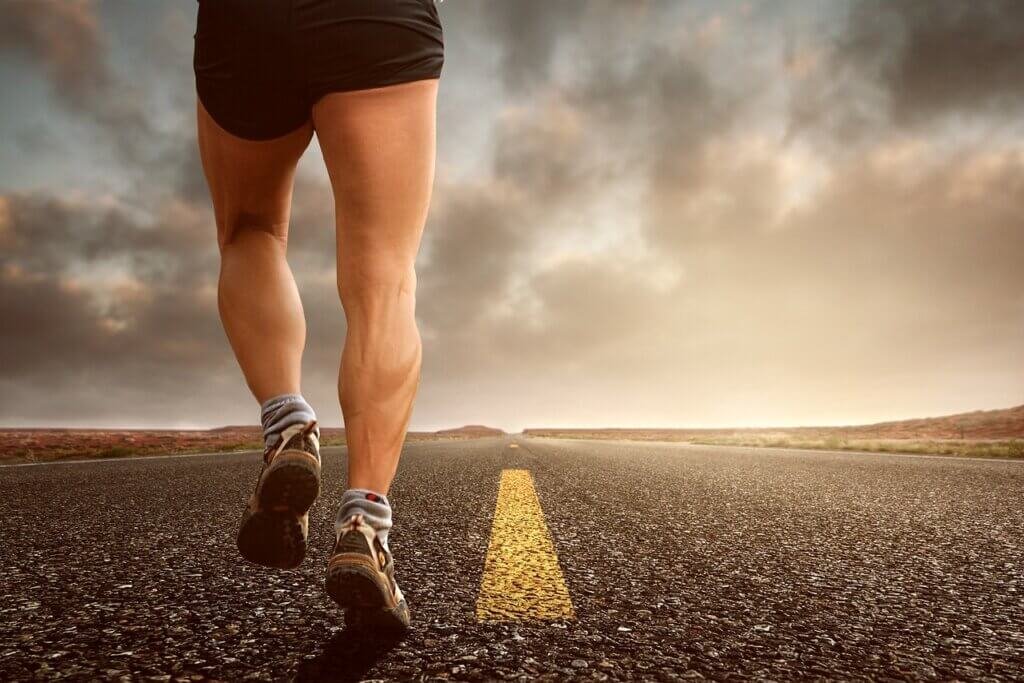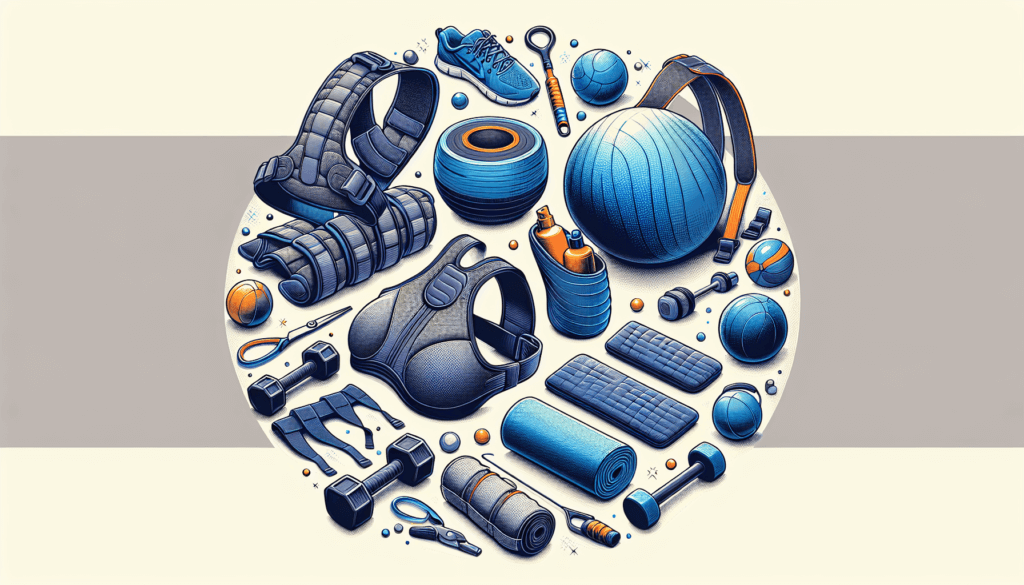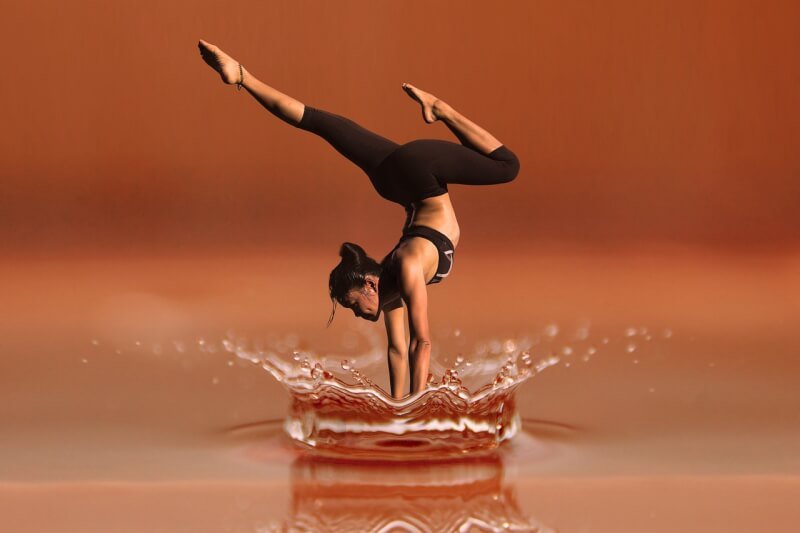Are you tired of experiencing back pain during your workouts? Look no further! In this article, we will explore a variety of workout accessories that can provide relief and support for your back, allowing you to exercise comfortably and pain-free. From lumbar support belts to foam rollers, we have got you covered. Say goodbye to those nagging aches and get ready to enjoy your workouts like never before. Let’s discover the perfect accessories that will alleviate your back pain and enhance your fitness journey.

Yoga equipment
Yoga mats
Yoga mats are an essential accessory for any yoga practitioner. They provide a comfortable and stable surface for performing various yoga poses and exercises. A good quality yoga mat offers cushioning to protect your joints and prevents slipping, allowing you to focus on your practice without any distractions. Look for a yoga mat that is thick enough to provide adequate support, yet lightweight and durable for easy transportation. From beginner-friendly mats to eco-friendly options, there is a wide range of yoga mats available to suit your preferences.
Yoga blocks
Yoga blocks are versatile props that can be used by yogis of all levels, from beginners to advanced practitioners. These blocks provide support and stability, allowing you to modify or deepen yoga poses according to your comfort and flexibility. Whether you need assistance for proper alignment or want to enhance your flexibility, yoga blocks can be invaluable tools. They are typically made of foam, cork, or wood, offering different levels of firmness and grip. Incorporating yoga blocks into your practice can help reduce strain on your back and prevent injuries.
Yoga straps
Yoga straps are another fantastic accessory that can enhance your yoga practice. These long, adjustable straps are primarily used for stretching and achieving proper alignment in various poses. They provide support and assistance in poses that require reaching or holding onto body parts that are difficult to access on your own, such as tight hamstrings or shoulders. Yoga straps can help improve flexibility and gradually increase your range of motion while minimizing strain on your back. They are especially beneficial for beginners who may need some extra help in certain poses.
Supportive footwear
Orthotic insoles
Orthotic insoles are specially designed shoe inserts that provide additional support and cushioning for your feet. They are recommended for individuals who suffer from foot problems such as overpronation, flat feet, or plantar fasciitis. By correcting your foot alignment and providing arch support, orthotic insoles help distribute pressure evenly, reducing strain on your back. They can be inserted into your existing shoes, making them a convenient choice for everyday use or when engaging in physical activities.
Cushioned running shoes
If you enjoy running or jogging, investing in a good pair of cushioned running shoes is essential. These shoes are designed to absorb shock and provide ample cushioning to protect your joints, including your back. Running on hard surfaces can put a significant amount of stress on your spine, leading to discomfort or even injuries. Cushioned running shoes help minimize the impact and provide a more comfortable running experience. Look for shoes with features such as additional padding, cushioned midsoles, and supportive heel counters to ensure optimal support for your back.
Arch support sandals
When it comes to supportive footwear, it’s important to consider your choices beyond just athletic shoes. Arch support sandals are an excellent option for those seeking comfort and support during the warmer months. These sandals are designed with built-in arch support to help maintain proper foot alignment and reduce strain on your back. They provide cushioning and shock absorption, making them ideal for those who spend long hours on their feet or suffer from foot conditions like plantar fasciitis. Look for sandals with adjustable straps and contoured footbeds for a customizable fit and maximum support.

Exercise balls
Stability balls
Stability balls, also known as exercise or Swiss balls, are large inflatable balls that can be used for a variety of exercises. These versatile tools are commonly used in fitness training, physical therapy, and even yoga. By sitting or lying on a stability ball, you engage your core muscles and improve balance and stability. This, in turn, helps alleviate back pain by strengthening the muscles that support your spine. Stability balls can also be utilized for stretching and low-impact exercises, offering an effective way to reduce muscle tension and enhance flexibility.
Swiss balls
Similar to stability balls, Swiss balls are another type of exercise ball that can be used for a wide range of exercises. They are most commonly associated with core workouts and strengthening exercises, as they require the engagement of multiple muscle groups. By incorporating Swiss balls into your workout routine, you can improve your posture, enhance body awareness, and alleviate back pain. These versatile balls are available in different sizes, so it’s important to choose one that suits your height and provides proper support for your back during exercises.
Medicine balls
Medicine balls are weighted balls that come in various sizes and weights. They are commonly used in strength training exercises to improve power, endurance, and coordination. While medicine balls primarily target the upper body and core muscles, they can indirectly help alleviate back pain by promoting overall strength and stability. By incorporating exercises such as medicine ball slams, twists, or throws into your routine, you can engage your core and back muscles, leading to improved posture and reduced strain on your back.
Back support braces
Elastic back braces
Elastic back braces are commonly used to provide support and stability to the lower back. They are typically made of a stretchable material that conforms to the shape of your body, offering a snug fit. These braces help alleviate back pain by providing compression and warmth to the affected area. By increasing blood circulation and promoting proper alignment, elastic back braces can provide temporary relief for individuals with acute or chronic back pain. It’s important to note that elastic back braces should be used as a complementary therapy along with proper medical advice or treatment.
Posture corrector braces
Poor posture is a common contributing factor to back pain. Posture corrector braces aim to help improve posture by providing gentle support and reminding you to maintain proper spinal alignment. These braces are usually worn around the upper back and shoulders, pulling them back to encourage a more upright posture. By retraining your muscles and promoting an aligned position, posture corrector braces can help alleviate back pain caused by slouching or hunching. However, it’s important to use them as directed and consult with a healthcare professional if you have any underlying conditions or concerns.
Lumbar support belts
Lumbar support belts are specifically designed to provide support to the lumbar region of the spine, which is the lower back area. These belts are usually made of a firm and adjustable material that can be worn around the waist. They help stabilize the lower back, relieve pressure on the discs, and promote proper alignment. Lumbar support belts are commonly used during heavy lifting or activities that involve repetitive bending or twisting movements. By reducing strain on your back and supporting the natural curvature of your spine, these belts can help alleviate back pain caused by physical exertion or poor posture.

Foam rollers
Textured foam rollers
Foam rollers are cylindrical tools made of dense foam that are used for self-myofascial release (SMR). By applying pressure to specific areas of your body, such as your back, these rollers help release tension and tightness in the muscles and fascia. Textured foam rollers have various patterns or ridges on their surface, providing a more intense massage-like effect. When used correctly, they help increase blood flow, relieve muscle knots, and promote relaxation. Incorporating textured foam rollers into your routine can be particularly beneficial for alleviating back pain and enhancing mobility.
Firm foam rollers
Firm foam rollers are another type of foam roller that offer a slightly different experience compared to textured ones. These rollers have a smooth surface and provide a more general and uniform pressure when rolled against your back or other body parts. They can be used for self-massage, stretching, or even exercises like balance training. Firm foam rollers help increase blood circulation, reduce muscle soreness, and improve range of motion. By gently rolling over your back, you can release tension and tightness in your muscles, relieving strain and discomfort.
Vibrating foam rollers
For an added therapeutic effect, vibrating foam rollers have become increasingly popular in the fitness and recovery realms. These foam rollers incorporate a vibrating mechanism that enhances the massage-like sensation and relaxation benefits. The vibrations generated by the roller help stimulate your muscles and increase blood flow, accelerating the recovery process and reducing muscle tension. Vibrating foam rollers can be particularly effective for relieving back pain and promoting relaxation after intense workouts or long periods of sitting. However, it’s important to start with lower intensity settings and gradually increase as per your comfort level.
Resistance bands
Loop bands
Loop bands, also known as mini bands or resistance loops, are elastic bands in a looped shape used for resistance training. These bands provide resistance when stretched, allowing you to engage various muscle groups. By incorporating loop bands into your workouts, you can strengthen your back muscles, improve posture, and prevent back pain. They offer a convenient and portable way to add resistance to exercises such as glute bridges, lateral walks, or rows. Loop bands come in different resistance levels, so you can choose the one that suits your fitness level and desired intensity.
Tube resistance bands
Tube resistance bands are long, flexible bands with handles on each end. They are commonly used for strength training exercises that target specific muscle groups, including those in the back. These bands provide resistance throughout the range of motion, making them ideal for building strength and muscular endurance. Tube resistance bands can be anchored to a stable object or used free-standing, allowing you to perform exercises like rows, lat pulldowns, or standing rotations. By incorporating these bands into your routine, you can strengthen your back muscles, improve stability, and reduce the risk of back pain.
Pull-up assist bands
Pull-up assist bands are specifically designed to provide assistance during pull-up exercises. These bands are typically looped around a pull-up bar or other stable structure, allowing you to use them as a counterweight. They help reduce the amount of body weight you need to lift, making pull-ups more accessible for individuals who may struggle to perform them unassisted. By gradually increasing the resistance of the bands, you can gradually build strength in your back and upper body, ultimately progressing towards unassisted pull-ups. Pull-up assist bands are a useful tool for strengthening the muscles that support your spine and alleviating back pain.

Inversion tables
Full inversion tables
Full inversion tables are specially designed tables that allow you to completely invert your body, positioning your head below your feet. This inversion therapy is believed to have several benefits, including decompression of the spine, improved circulation, and reduced muscle tension. By hanging upside down, the pull of gravity helps stretch your spine and relieve pressure on the discs. Full inversion tables can be used to alleviate back pain caused by conditions like sciatica or herniated discs. However, it’s important to consult with a healthcare professional before using an inversion table, as it may not be suitable for everyone.
Teeter inversion tables
Teeter inversion tables are a popular brand of inversion tables that have gained recognition for their quality and effectiveness. These tables provide a safe and controlled way to experience the benefits of inversion therapy. Teeter inversion tables are designed with features such as adjustable settings, ergonomic backrests, and ankle support systems to ensure optimal comfort and alignment during inversion. They are suitable for individuals of various heights and weights, offering customizable options for a personalized inversion experience. Whether you’re looking to alleviate back pain or simply relax, Teeter inversion tables provide a reliable and user-friendly option.
Foldable inversion tables
For those with limited space or the need for portability, foldable inversion tables offer a convenient solution. These tables function similarly to full inversion tables but provide the added feature of easy storage and transport. Foldable inversion tables can be collapsed and folded into a compact size, allowing you to conveniently slide them under a bed or store them in a closet when not in use. Despite their foldable design, these tables maintain the same functionality and effectiveness as their non-foldable counterparts. If you’re short on space or prefer a portable option, foldable inversion tables are worth considering for back pain relief.
Massage tools
Massage balls
Massage balls are small, portable tools that can provide targeted relief for specific areas of your body, including your back. These balls can be used for self-massage by applying pressure to tight or sore muscles, helping release tension and alleviate discomfort. Massage balls are particularly effective for trigger point therapy, where you can locate and target specific knots or trigger points in your muscles. By rolling the massage ball over your back or leaning against it against a wall, you can apply controlled pressure and stimulate blood flow, promoting muscle relaxation and reducing back pain.
Foam massage rollers
Foam massage rollers, also known as foam massage sticks or massage sticks, are versatile tools that can be used for self-massage on various parts of your body, including your back. These rollers are typically cylindrical in shape and made of foam or other soft materials. By rolling the foam massage roller over your back, you can release muscle tension, improve circulation, and enhance flexibility. Foam massage rollers are available in different sizes and densities, allowing you to choose one that suits your comfort level and desired pressure. Incorporating foam massage rollers into your routine can help alleviate back pain and promote overall physical well-being.
Percussion massagers
Percussion massagers are handheld devices that use rapid and repetitive movements to provide deep tissue massage. These massagers typically come with different attachments or heads, allowing you to customize the intensity and target specific areas of your body, including your back. By using a percussion massager, you can apply targeted pressure to your back muscles, helping relieve muscle tension, reduce pain, and enhance recovery. The percussive action of these massagers helps increase blood flow and stimulate the nervous system, promoting relaxation and alleviating back pain. When using a percussion massager, it’s important to start with a lower setting and gradually increase as per your comfort level.
Body pillows
Pregnancy body pillows
Pregnancy body pillows are specially designed to provide support and comfort for expecting mothers. These pillows are typically long and shaped like a letter “C” or “U,” allowing pregnant women to comfortably rest or sleep in various positions. By providing support to the back, hips, and belly, pregnancy body pillows help alleviate the strain on the back and other areas of the body. They can also be used for positioning during breastfeeding or as a support cushion postpartum. Pregnancy body pillows are available in different sizes and materials, catering to the individual needs and preferences of expectant mothers.
U-shaped body pillows
U-shaped body pillows are a popular choice for those seeking full-body support and alignment during sleep. These pillows are shaped like a letter “U” and provide support for both sides of the body simultaneously. By hugging the pillow or positioning it between your legs, you can maintain proper spinal alignment and reduce strain on your back while sleeping. U-shaped body pillows are often recommended for individuals with back pain, pregnancy discomfort, or those who prefer a cuddly and supportive sleeping experience. They come in various sizes and fillings, offering customizable options for optimal comfort and relief.
Memory foam body pillows
Memory foam body pillows are designed to conform to your body shape, providing customized support and contouring to your curves. These pillows are made of memory foam, a material that responds to body heat and pressure, molding itself to your body. By using a memory foam body pillow, you can align your spine and reduce pressure points, relieving back pain and promoting better sleep quality. These pillows also offer excellent heat dissipation, allowing for a cooler and more comfortable sleeping experience. Memory foam body pillows are available in different sizes and densities, catering to individual preferences and sleeping positions.
Kettlebells
Swing kettlebells
Swing kettlebells are a versatile and effective tool for strength training and cardiovascular workouts. These kettlebells have a unique design with a handle and a rounded weight attached to it. By performing swing movements with the kettlebell, you engage multiple muscle groups, including those in your back. This full-body exercise helps improve strength, endurance, and mobility while providing a cardio challenge. By incorporating swing kettlebell exercises into your routine, you can strengthen your back muscles, improve posture, and reduce the risk of back pain. It’s essential to learn proper form and start with an appropriate weight under the guidance of a trained professional.
Goblet kettlebells
Goblet kettlebells are another type of kettlebell that can be used for a variety of exercises, including those targeting your back muscles. These kettlebells have a rounded weight with a flat bottom and a handle that allows for a comfortable grip. Goblet kettlebell exercises, such as the goblet squat or the kettlebell row, help strengthen your back, shoulders, and core muscles. By practicing these exercises with proper form, you can improve your posture, enhance stability, and reduce the risk of back pain. Goblet kettlebells come in different weights, allowing you to choose the appropriate resistance for your fitness level.
Kettlebell rows
Kettlebell rows are a compound exercise that targets the muscles in your upper back, including the latissimus dorsi. These rows help strengthen the muscles responsible for pulling movements, promoting better posture and reducing the risk of back pain. To perform kettlebell rows, you need a sturdy kettlebell and a bench or elevated surface to support your opposite arm and leg. By maintaining a stable position and focusing on proper form, you can engage your back muscles and perform controlled rowing movements. Kettlebell rows offer a challenging and effective way to build back strength and alleviate discomfort.


